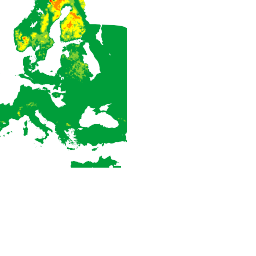什么是通用花粉指数 (UPI)?
通用花粉指数 (UPI) 旨在提供一个全球统一的衡量标准,以便比较不同地区的花粉浓度。该指数可帮助对花粉过敏或对花粉敏感的人群根据各种因素评估花粉暴露风险。该模型基于多层模型,可表示花粉水平数据,其中考虑了每种植物模型的浓度、全球使用的许多不同的本地花粉指数 (LPI),以及不同植物花粉类型的致敏性,以预测每天每立方米的花粉粒数(粒/立方米)。
heatmapTiles 端点会返回可叠加在基础地图上的热图图块。热力图图块显示了给定植物类型(TREE、GRASS 或 WEED)在全球范围内的 UPI。
该指数包含六个类别:
| 值 | 颜色 | 说明 |
|---|---|---|
| 0 | 无 | |
| 1 | 电量非常低 | |
| 2 | 低 | |
| 3 | 中 | |
| 4 | 高 | |
| 5 | 非常高 |
每个类别都基于特定区域中花粉的具体浓度水平及其对通常出现的过敏症状严重程度的影响,从而全面呈现花粉水平。通过集成 UPI,用户可以比较和评估不同地点的花粉状况。
例如,以下热图图块显示了 TREE 花粉含量,范围从极低到极高:

支持的植物
花粉 API 支持 3 种不同类型的植物:草、杂草和树。由于植物的供应情况取决于实际数据源的测量结果和报告,因此 Pollen API 的植物数据可能会因地点而异。
下表显示了支持的工厂代码及其元数据:
| 工厂代码 | 显示名称 | 类型 |
|---|---|---|
ALDER |
Alder | 树形 |
ASH |
白蜡树 | 树形 |
BIRCH |
桦木灰 | 树形 |
COTTONWOOD |
Cottonwood | 树形 |
ELM |
Elm | 树形 |
MAPLE |
Maple | 树形 |
OLIVE |
橄榄绿 | 树形 |
JUNIPER |
Juniper | 树形 |
OAK |
橡木 | 树形 |
PINE |
Pine | 树形 |
CYPRESS_PINE |
柏松 | 树形 |
HAZEL |
灰棕色 | 树形 |
GRAMINALES |
草类 | 草 |
JAPANESE_CEDAR |
日本雪松 | 树形 |
JAPANESE_CYPRESS |
日本柏树 | 树形 |
RAGWEED |
豚草 | Weed |
MUGWORT |
艾蒿 | Weed |

